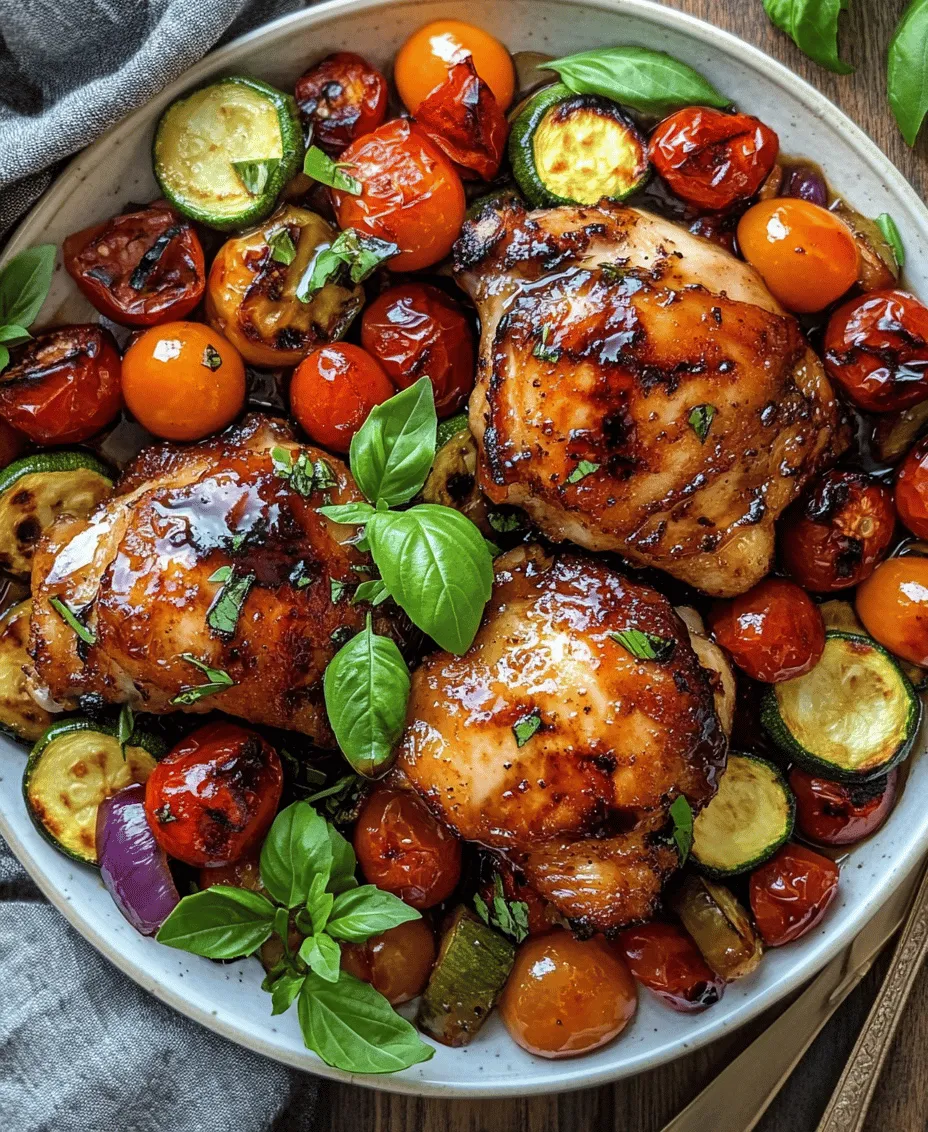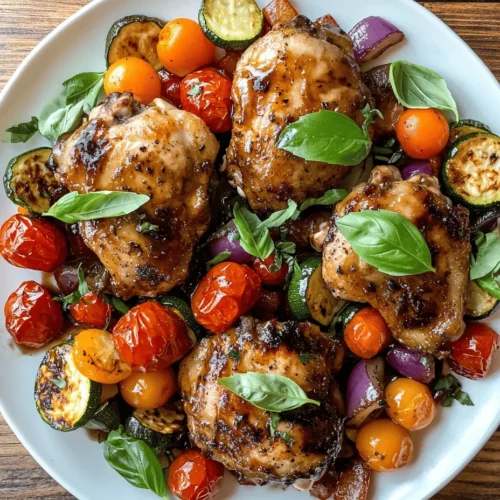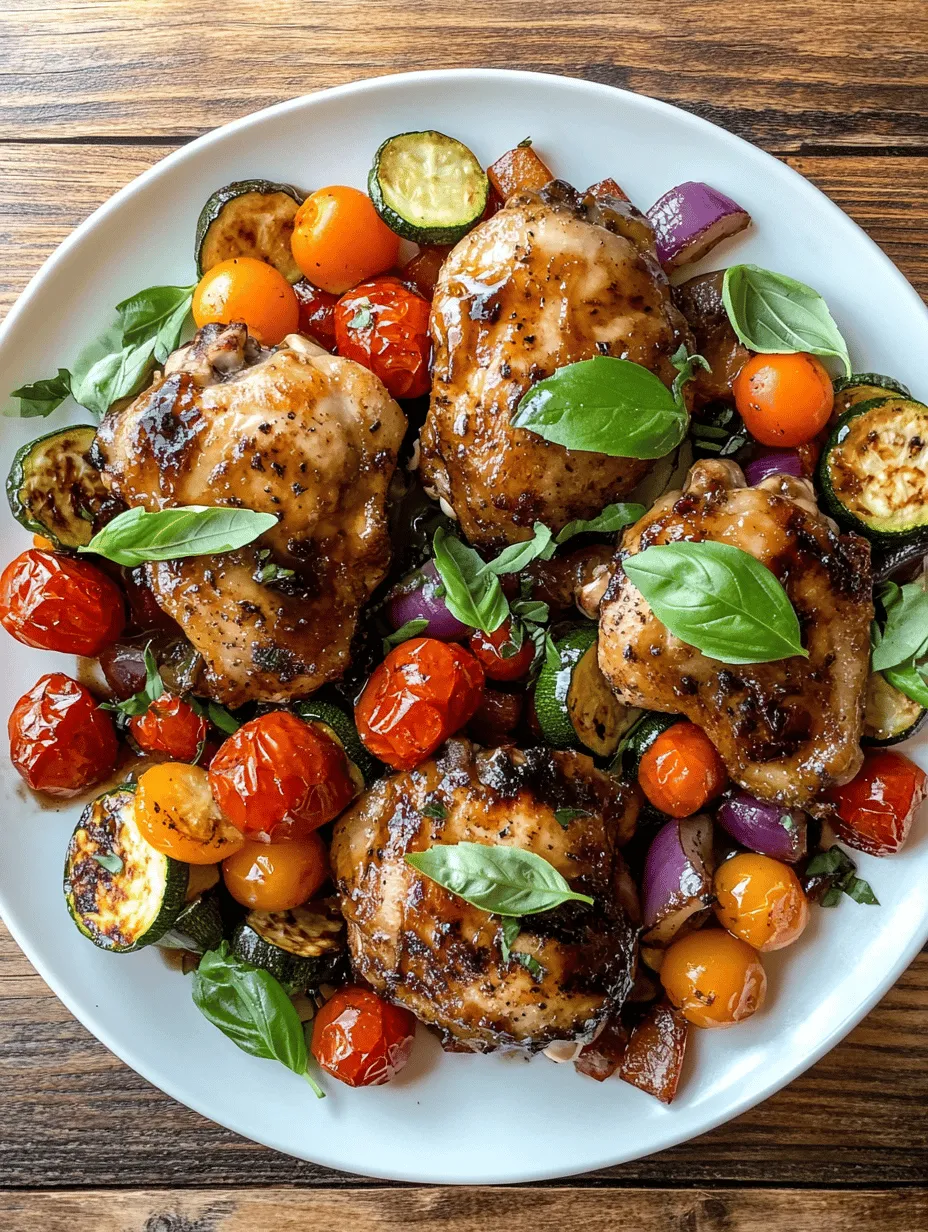When it comes to quick, nutritious meals that don’t compromise on flavor, Balsamic Glazed Chicken and Veggies stands out as a top contender. This dish seamlessly combines tender chicken thighs with a vibrant medley of fresh vegetables, all enhanced by a beautifully balanced balsamic glaze. It’s not just a feast for the taste buds but also a colorful presentation that makes it perfect for family dinners or impressing guests at gatherings. In just one pan, you can create a mouthwatering meal that is both visually appealing and packed with nutritional benefits.
The Appeal of Balsamic Glazed Chicken and Veggies
In today’s fast-paced world, finding meals that are both quick to prepare and wholesome is paramount. Balsamic Glazed Chicken and Veggies delivers on both fronts. The dish is not only easy to throw together but also brings a delightful array of flavors that appeal to both adults and children. The combination of tender chicken, fresh vegetables, and a tangy-sweet glaze creates a satisfying meal that leaves everyone happy and full.
Moreover, this recipe champions the use of fresh, seasonal produce. When you incorporate vibrant vegetables like cherry tomatoes, zucchini, and bell peppers, you boost the dish’s nutritional profile significantly. Fresh produce is loaded with vitamins, minerals, and antioxidants, making this dish a healthy option that doesn’t skimp on taste. The unique flavor of balsamic vinegar, paired with honey, elevates the dish, turning simple ingredients into a gourmet experience right in your kitchen.
Understanding the Ingredients
Every great recipe starts with understanding its ingredients. Let’s delve into the core components of Balsamic Glazed Chicken and Veggies, exploring their roles and health benefits.
Exploring Chicken Thighs
Chicken thighs are the star of this dish, and for good reason. Compared to chicken breasts, thighs offer a richer flavor and are generally more forgiving when it comes to cooking. The nutritional benefits of chicken thighs include:
– Higher Fat Content: Chicken thighs have a higher fat content than breasts, which contributes to their juiciness and flavor. This makes them less likely to dry out during cooking.
– Rich in Essential Nutrients: They are a good source of protein, iron, and zinc, essential for maintaining muscle mass and overall health.
For this recipe, opting for boneless, skinless chicken thighs is ideal. This cut cooks more evenly and is easier to handle. The absence of bones makes it simpler to slice and serve, allowing the flavors of the balsamic glaze to penetrate the meat better.
The Power of Fresh Vegetables
The medley of vegetables used in this dish not only adds color but also brings an array of health benefits that are hard to overlook. Here’s a closer look at the key vegetables:
– Cherry Tomatoes: These bite-sized gems are packed with antioxidants such as lycopene, which is known for its heart-health benefits. Their natural sweetness contrasts beautifully with the tangy glaze.
– Red Bell Pepper: Rich in vitamins A and C, red bell peppers add a sweet crunch that complements the chicken. They are also high in fiber, aiding digestion.
– Zucchini: Low in calories and high in water content, zucchini is a great way to bulk up your meal without adding many calories. It provides a mild flavor that absorbs the glaze beautifully.
– Red Onion: This vegetable adds a sharp bite that balances the sweetness of the other ingredients. It is also rich in antioxidants and has anti-inflammatory properties.
When selecting vegetables, aim for seasonal and fresh produce. Not only do they taste better, but they also offer enhanced nutritional benefits.
The Magic of Balsamic Vinegar and Honey
At the heart of this dish is the balsamic glaze, which combines balsamic vinegar and honey to create a depth of flavor that is simply irresistible.
– Balsamic Vinegar: Known for its rich, complex flavor profile, balsamic vinegar adds an umami punch that elevates the chicken and vegetables. Its acidity helps to tenderize the meat, ensuring that every bite is juicy and flavorful.
– Honey: The addition of honey serves to balance the acidity of the vinegar. It brings a touch of sweetness that harmonizes with the savory elements of the dish, resulting in a glaze that clings beautifully to the chicken and veggies.
Preparation Steps Explained
Now that we’ve covered the ingredients, let’s move on to the preparation steps. Each phase is crucial to achieving the best results, from marinating the chicken to properly cooking the vegetables.
Marinating the Chicken
Marinating is a key step in this recipe that enhances the flavor of the chicken. Here’s how to do it effectively:
– Importance of Marinating: By allowing the chicken to soak in the balsamic mixture, you infuse it with flavor and moisture. The vinegar not only adds taste but also helps to tenderize the meat, making it more succulent.
– Tips for Achieving the Perfect Marination Time: Ideally, marinate the chicken for at least 30 minutes. However, for maximum flavor, consider marinating for up to 2 hours. If you’re short on time, even a quick 15-minute soak can make a difference.
To prepare the marinade, combine balsamic vinegar, honey, minced garlic, salt, and pepper in a bowl. Whisk until well combined, then pour it over the chicken in a resealable bag or shallow dish. Make sure the chicken is evenly coated and refrigerate it while you prep the veggies.
Preparing the Vegetables
Properly prepping your vegetables can make all the difference in this dish. Here are some techniques to ensure even cooking:
– Slicing Techniques: Aim for uniform pieces when slicing your vegetables. This ensures that they cook evenly. For cherry tomatoes, simply halve them; for bell peppers and zucchini, cut them into bite-sized chunks. Red onions can be sliced into thin wedges for a beautiful presentation.
– Suggestions for Alternative Vegetables: Feel free to customize your vegetable selection based on what’s in season or what you have on hand. Asparagus, broccoli, or snap peas can be excellent substitutes that add variety and nutrition.
Cooking Techniques and Tips
The final step is to cook the chicken and vegetables to perfection. Here are some essential tips to help you achieve optimal results:
– Proper Skillet Heating and Oil Usage: Start by heating a large skillet over medium-high heat. Once hot, add a drizzle of olive oil. This will help create a nice sear on the chicken, locking in juices and flavor.
– Checking for Doneness: To ensure your chicken is cooked through but still juicy, use a meat thermometer. The internal temperature should reach 165°F (75°C). Allow the chicken to rest for a few minutes after cooking to retain its moisture before slicing.
By following these preparation steps, you’ll be well on your way to creating a delicious Balsamic Glazed Chicken and Veggies that is sure to impress. In the next section, we’ll explore the cooking process in detail, including how to master the glaze for the ultimate flavor experience. Stay tuned!

Sautéing the Vegetables
When preparing Balsamic Glazed Chicken and Veggies, sautéing the vegetables is a crucial step that significantly impacts the final dish’s flavor and texture. To achieve perfectly sautéed vegetables, follow these best practices:
1. Choose the Right Pan: Use a large, heavy-bottomed skillet or sauté pan, which distributes heat evenly and prevents food from sticking. Stainless steel or cast iron are excellent choices.
2. Preheat the Pan: Before adding any oil, preheat your pan over medium-high heat. A properly heated pan ensures that vegetables start cooking immediately, which helps maintain their crispness.
3. Use the Right Oil: Choose oils with a high smoke point, such as olive oil, avocado oil, or canola oil. This prevents burning and allows for better flavor infusion.
4. Cut Vegetables Evenly: To ensure uniform cooking, cut your vegetables into similar sizes. This allows them to cook at the same rate and helps maintain their crunch.
5. Don’t Overcrowd the Pan: Cook in batches if necessary. Overcrowding can lead to steaming rather than sautéing, resulting in soggy vegetables. Give them enough space to caramelize and develop rich flavors.
6. Season Wisely: Add salt and pepper at the beginning of cooking to enhance the natural flavors of the vegetables. Consider adding garlic or herbs during the last few minutes of cooking for a fragrant finish.
7. Check for Texture: The goal is to achieve tender-crisp vegetables. Depending on the type, this usually takes about 5-7 minutes. Keep a close eye and stir occasionally to ensure even cooking.
By following these tips, your sautéed vegetables will not only be vibrant in color but also provide a satisfying crunch that complements the tender chicken.
Glazing the Chicken
The glazing process is where the magic happens, infusing the chicken with a rich, tangy flavor that elevates the entire dish. Here’s how to effectively glaze the chicken for optimal flavor and texture:
1. Prepare the Glaze: As your vegetables are finishing up, prepare the balsamic glaze. In a small saucepan, combine balsamic vinegar, honey (or maple syrup for a vegan option), and a touch of soy sauce. Bring this mixture to a gentle simmer over medium heat until it thickens slightly, about 5-7 minutes.
2. Coating the Chicken: Once the chicken is cooked through and reaches an internal temperature of 165°F (75°C), pour the glaze over the chicken in the pan. Use a spatula or tongs to ensure each piece is evenly coated. Allow the glaze to bubble and thicken around the chicken for about 2-3 minutes, stirring gently.
3. Knowing When It’s Ready: The glaze is ready when it clings to the chicken and has a glossy finish. If it becomes too thick, you can add a splash of water or broth to loosen it up. The chicken should look shiny and appetizing, with the balsamic sauce glistening.
4. Let It Rest: After glazing, allow the chicken to rest for a few minutes before slicing. This helps the juices redistribute, ensuring the chicken remains moist and flavorful.
Serving Suggestions
Balsamic Glazed Chicken and Veggies can be presented in ways that enhance its appeal and dining experience. Here are some effective plating techniques and garnishing ideas:
Plating Techniques
1. Layering: Start by placing a bed of sautéed vegetables on the plate. This not only provides a colorful base but also ensures the chicken sits above it, allowing the glaze to drizzle down.
2. Slicing the Chicken: For an elegant presentation, slice the glazed chicken into medallions and fan them out over the vegetables. This technique adds visual interest and showcases the glaze beautifully.
3. Use of Color: Brightly colored vegetables like bell peppers, carrots, and green beans create a vibrant contrast against the dark glaze. Arrange them artfully to highlight their colors.
4. Sauce Drizzle: Use a spoon to drizzle extra balsamic glaze around the plate for an artistic touch. This not only looks appealing but adds extra flavor with every bite.
Garnishing Ideas
– Fresh Herbs: Sprinkle chopped fresh basil or parsley over the dish just before serving to add a pop of color and freshness. These herbs not only enhance the visual appeal but also complement the flavors beautifully.
– Lemon Zest: A light sprinkle of lemon zest can brighten up the dish, adding a refreshing citrus aroma that balances the richness of the glaze.
Pairing Options
To elevate your meal further, consider these complementary side dishes and beverage options:
Recommended Sides
1. Quinoa or Brown Rice: These grains provide a wholesome base that absorbs the flavors of the chicken and glaze while adding additional nutrients.
2. Garlic Mashed Potatoes: Creamy mashed potatoes pair well with the tangy glaze, creating a comforting and satisfying meal.
3. Mixed Green Salad: A simple salad with a vinaigrette dressing can add a refreshing contrast to the rich flavors of the chicken and veggies.
4. Roasted Potatoes: Crispy roasted potatoes seasoned with herbs can add texture and flavor, enhancing the overall dining experience.
Beverage Pairings
– White Wine: A crisp Sauvignon Blanc or a light Chardonnay complements the balsamic flavors and enhances the meal’s sophistication.
– Iced Tea: For a non-alcoholic option, serve a refreshing iced tea with lemon. Its subtle sweetness and acidity will harmonize well with the dish.
Nutritional Information
Balsamic Glazed Chicken and Veggies not only delight the palate but also offer significant nutritional benefits. Here’s a breakdown of the dish’s nutritional content:
Caloric Breakdown
One serving of Balsamic Glazed Chicken and Veggies (with approximately 4 oz of chicken and 1 cup of sautéed vegetables) contains roughly 350-400 calories. This makes it a great option for those looking to enjoy a satisfying meal without excessive calories.
Macronutrient Profiles
– Protein: The chicken provides a substantial amount of protein, approximately 30 grams per serving, crucial for muscle repair and overall health.
– Fats: With healthy fats from the olive oil used in sautéing, the dish contains about 10-15 grams of fat, primarily unsaturated fats, which are beneficial for heart health.
– Carbohydrates: The vegetables contribute around 20-25 grams of carbohydrates, providing essential fiber and energy.
Vitamins and Minerals
This dish is packed with essential vitamins and minerals, such as:
– Vitamin A: From bell peppers and carrots, supporting eye health and immune function.
– Vitamin C: Present in various vegetables, aiding in iron absorption and boosting the immune system.
– Potassium: Found in chicken and veggies, crucial for maintaining healthy blood pressure levels.
– Antioxidants: Balsamic vinegar and fresh herbs provide antioxidant properties that promote overall well-being.
Conclusion
Balsamic Glazed Chicken and Veggies is a delightful dish that brings together the tangy sweetness of balsamic vinegar with tender chicken and crisp vegetables. Its ease of preparation makes it ideal for busy weeknights or special occasions alike. Not only does it taste incredible, but it’s also packed with nutrients, making it a healthy choice for any meal.
We encourage you to try this recipe and make it your own by experimenting with different vegetables or adjusting the glaze to suit your taste. Cooking with fresh ingredients is a rewarding experience that fosters creativity in the kitchen. Enjoy the process, and savor the delicious results!


